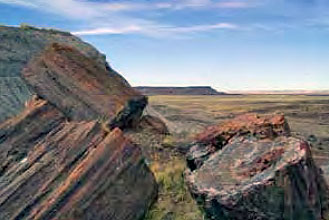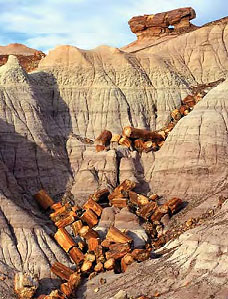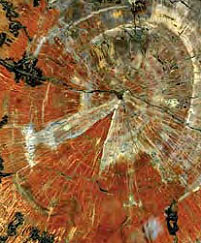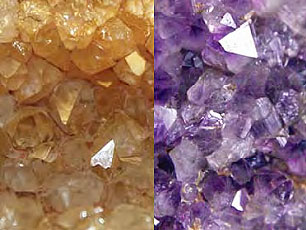What is Petrified Wood?

Petrified logs at the Petrified Forest National Park near Holbrook, Arizona. Image by the National Park Service.
Petrified wood is a fossil. It forms when plant material is buried by sediment and protected from decay by oxygen and organisms. Then, groundwater rich in dissolved solids flows through the sediment replacing the original plant material with silica, calcite, pyrite or another inorganic material. The result is a fossil of the original woody material that often exhibits preserved details of the bark, wood and cellular structures.
Some specimens of petrified wood are such accurate preservations that people do not realize they are fossils until they pick them up and are shocked by their weight. These specimens with near perfect preservation are unusual; however, specimens that exhibit clearly recognizable bark and woody structures are very common.
Petrified Forest National Park

An accumulation of petrified logs in a gulley at Petrified Forest National Park. At the top of the gulley a ‘pedistal log’ is suspended on a column of Chinle Formation. When the Chinle weathers away the log will be lowered to the ground surface. Image by Petrified Forest National Park.
The most famous locality for observing petrified wood is Petrified Forest National Park near the community of Holbrook in northeastern Arizona. About 225 million years ago this area was a lowland with a tropical climate and covered by a dense forest. Rivers flooded by tropical rain storms washed mud and other sediments into the lowlands. Enormous coniferous trees up to 9 feet in diameter and 200 feet tall lived and died in these lowlands. Fallen trees and broken branches were often buried by the river sediments. Nearby volcanoes erupted numerous times. These eruptions blanketed the area in volcanic ash with a high silica content.
Rapid burial allowed the plant debris to escape destruction by oxygen and insects. The soluble ash was dissolved by groundwater flowing through the sediments. The dissolved ash served as a source of silica that replaced the plant debris, creating petrified wood. Trace amounts of iron, manganese and other minerals were included in the silica and gave the petrified wood a variety of colors. These sediments, plant debris and volcanic ash became part of a rock unit known today as the Chinle Formation.
In the millions of years after the Chinle Formation was deposited the area was uplifted and the rocks deposited above the Chinle were been eroded away. The petrified wood is much harder and resistant to weathering than the mud rocks and ash deposits of the Chinle. Instead of eroding away the wood accumulated on the ground surface as the surrounding mud rocks and ash layers were eroded away. That is why areas of the Park are covered with a litter of petrified wood trunks, branches and fragments. Today, visitors to the park can observe the petrified wood and photograph it; however, collecting petrified wood in the park is prohibited.
Other Petrified Wood Localities

Photograph of a polished crosssection of a petrified log from Arizona. You can see the structure of the wood and even insect borings. Image by Michael Gäbler.
Petrified wood is not rare. It is found in volcanic deposits and sedimentary rocks at many of locations worldwide. It is sometimes found where volcanic activity covered plant material with ash, mudflows or pyroclastic debris. It is found where wood in sedimentary deposits was replaced by minerals precipitated from groundwater. It is especially abundant around coal seams, although many of the wood specimens in these locations are casts and molds rather than petrifications.
In the United States, noteworthy locations where abundant fossilized wood can be seen include:
- Petrified Forest National Park near Holbrook, Arizona
- Ginkgo Petrified Forest near Wanapum Reservoir, Washington
- The Petrified Forest near Calistoga, California
- Mississippi Petrified Forest near Flora, Mississippi
- Gilboa Fossil Forest near Gilboa, New York
- Florissant Fossil Beds near Florissant, Colorado
- Gallatin Petrified Forest near Yellowstone, Wyoming
- Escalante Petrified Forest State Park near Escalante, Utah
- Petrified Wood Park near Lemmon, South Dakota (a rock sculpture park – some made of local petrified wood)
Petrified Wood by Many Other Names

Some petrified logs contain a spectacular surprise. Cavities within them served as crystallization locations for quartz crystals such as the citrine (yellow, left ) and amethyst (purple, right) shown here. Images by Petrified Forest National Park.
A wide variety of names are commonly used for petrified wood. ‘Fossilized wood’ is a general term for wood that has been petrified or preserved by other methods of fossilization. ‘Opalized Wood’ is petrified wood that has been replaced by opal, an amorphous form of silica. ‘Agatized wood’ is wood that has been replaced by agate, a form of chalcedony or microcrystalline quartz. ‘Silicified wood’ is wood that has been replace by any form of silica, including opal and agate.
Lapidary Uses of Petrified Wood
Petrified wood is often used in lapidary work. It is cut into shapes for making jewelry, sawn into blocks to make bookends, sawn into thick slabs to make table tops, and sawn into thin slabs for clock faces, cabochons and many other crafts. Small pieces of petrified wood can be placed in a rock tumbler to make tumbled stones. Only a small fraction of petrified wood is suitable for lapidary work. Poorly preserved specimens, those with lots of voids or closely spaced fractures do not polish well or break while being worked. Workable specimens with spectacular color can sell for over $100 per pound.
Contributor: Hobart King geology.com/stories/13/petrified-wood/